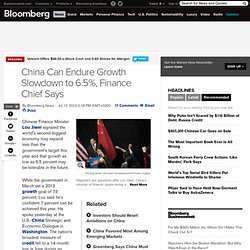

Why China Will Disappoint the Pessimists Yet Again. China’s eagerly anticipated “hard landing” hasn’t happened yet, and recent indicators make me wonder (not for the first time) if it ever will.

In the past two months, the Chinese economy has actually shown signs of accelerating. Constant pessimism in financial markets about the country’s prospects is only partly guided by economic analysis. There’s also the faith-based view that growth as rapid as China’s simply can’t go on -- and that a non-democratic country really shouldn’t expect to prosper. Many skeptics have been highlighting China’s impending collapse for almost as long as I have been following the country. Maybe the skeptics should be viewed a little more skeptically. By the end of this year, China’s gross domestic product will be roughly $9 trillion, making its economy comfortably more than half the size of the U.S., and half as big again as Japan. One Trillion For many analysts, none of this is enough. Chinese Growth and the Question of Economic Rebalancing. As far back as 2007, then premier Wen Jiabao described the Chinese economy as “unstable, unbalanced, uncoordinated and unsustainable”.

Although the statement raised eyebrows at the time, Mr. Wen’s words seem to have done little to temper the optimism-infused consensus on China’s expected growth rate in the coming years. One reason for this (apart from a massive investment boom) is the momentum sustaining the current high-powered growth status quo: investment houses selling freshly minted “China opportunity” funds, commodities producers – not to mention the current Chinese leadership – are all banking on high rates of growth extending into the distant future.
Especially in light of the Economic quagmire facing the developed West, ‘China as the engine of global growth’ has become a compelling story. According to official statistics, the Chinese growth rate has averaged over nine percent for the past three decades. I: Why has China boomed? Growth and Rebalancing: Jan Kregel on Chinese economy - NABATAEANS : NABATAEANS. China's slowdown: to stimulate, or not to stimulate? China needs a new growth model, not a stimulus. China Can Endure Growth Slowdown to 6.5%, Finance Chief Says. Chinese Finance Minister Lou Jiwei signaled the world’s second-biggest economy may expand less than the government’s target this year and that growth as low as 6.5 percent may be tolerable in the future.

While the government in March set a 2013 growth goal of 7.5 percent, Lou said he’s confident 7 percent can be achieved this year. He spoke yesterday at the U.S. -China Strategic and Economic Dialogue in Washington. The nation’s broadest measure of credit fell to a 14-month low in June during an interbank cash squeeze, central bank data showed today. Lou’s comments suggest China is prepared to allow a further slowdown from a rate that’s already at risk of falling to a 23-year low this year as Premier Li Keqiang focuses on policy changes to create more sustainable expansion. “We don’t think 6.5 percent or 7 percent will be a big problem,” Lou said at a press briefing in response to a question on whether there’s a limit on slower growth that officials will tolerate.
Growth Targets False Rally. China Exports Unexpectedly Drop; Imports in Economy Drag. China’s exports and imports unexpectedly declined in June, underscoring the severity of the slowdown in the world’s second-biggest economy as Premier Li Keqiang reins in credit growth.

Overseas shipments fell 3.1 percent from a year earlier, the most since the global financial crisis, data from the General Administration of Customs showed in Beijing today, compared with the median estimate of a 3.7 percent gain in a Bloomberg News survey. Imports dropped 0.7 percent, while the median projection was for a 6 percent increase. Exports to the U.S. and European Union declined for a fourth straight month while the drop in imports resulted in part from falling commodity prices. Weaker global and domestic demand, highlighted by China’s biggest shipyard outside state control seeking a government bailout, increases pressure on Li to support growth that’s at risk of sliding to the weakest since 1990 even as he vows to press on with restructuring the economy.
Trade Surplus No Revision Orders Plunge. The China slowdown effect.